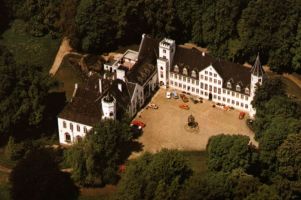
The Schleswig-Holstein State Archive, for commemorating his death, some 400 years ago, in 1598, at Breitenburg Castle.

Breitenburg, as it looks now.
HISTORY
One of the first things you'll want to know is what this site is about.
Partly it is about the history of one of the oldest noble families in the North of Germany, its notable individuals and, eventually, about their influence on the times they lived in.
I became interested in the most prominent member, viz. Henrik Rantzau, and kept adding the rest of the family. Just now I only recorded the basic facts, and the web site as of now is only a small part of what I know about them. Gradually I will add bits and pieces of their history, or somebody might take over from me.
The other part is about why it started in the first place, my adventures in develloping it and information for, and about, my in-law Danish family. I started with the complete results of one of their foremother's short relation with one of the lesser members of that Rantzau family, which occurred in the summer of 1831 on the Danish island of Funen, at Krengerup manor. This was only known by my in-law family as a "family story", no facts whatsoever. In the mean time I have added the other forefathers of my daughter, also the Dutch part.
There have been a lot of scientific studies about Henrik. (This is not! However, if any of the individuals or institutions which so friendly helped me should be interested, or any future student, they are welcome.) Some of these individuals are:
W. Steinmetz, about his artistic activities
D. Lohmeier, on humanism and renaissance
O. Brand, about his diplomatic activities
W. Lorentzen, about his castles and manors
|
|
|
The Schleswig-Holstein State Archive, for commemorating his death, some 400 years ago, in 1598, at Breitenburg Castle.
|
|
|
|
Breitenburg, as it looks now. |
|
|
Breitenburg, as it used to look. |
Hjördis Jahneke has recently written a thesis about its architecture and its gardens.
Peter Zeeberg, a latinist who ao translated the Saxo Chronicles into modern Danish, wrote a bibliography about the books Henrik had published and sent to famous Europeans of the time and exploring the "dedications" in these books. I was able to contribute one I found at the Royal Library in the Hague.
For me it is fun to discover small inaccuracies in these publications. For example, in the last mentioned book it says that the "Rantzau Table", which is a painting of the family tree, is to be found at Krengerup, while it is at Rosenvold Castle.
Krengerup Manor is now being used for cultural events. (To the flax museum, which is also situated there, I owe the description of Krengerup lower down)
For further information, see under Vips.
The name Rantzau is first mentioned in 1226, and to prove this I have here added the relevant documents, about the founding of the Preetz, in Schleswig-Holstein, cloister.
|
|
|